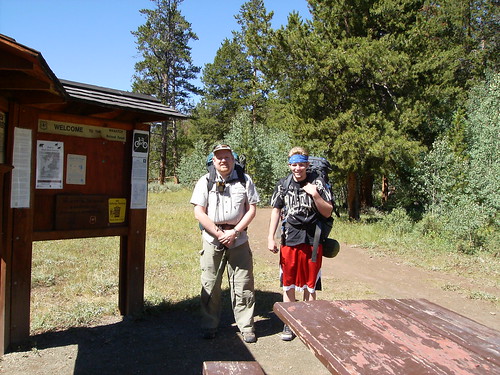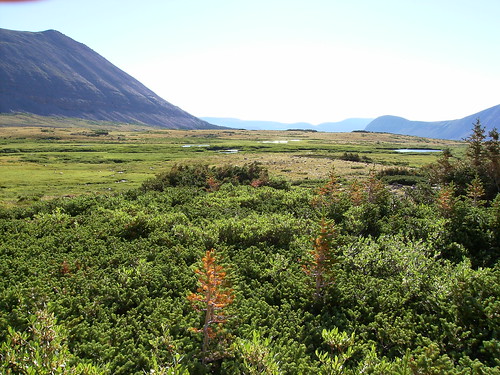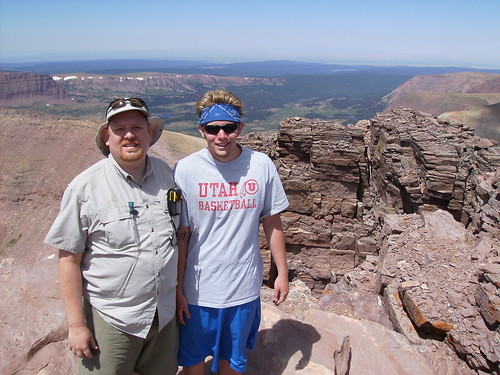See And Be Seen
Originally posted at my old blog geekcyclist.blogspot.com
At work we recently switched from a standard 5x8 schedule to a 4x10 schedule. Among the other complications of this change is one of particular concern for cyclists. While in the past there was a major portion of the year where I could ride without lights, it seems I will need to use my lighting system year-round now. A couple of co-workers have asked what kind of lighting system I use so I thought I would share my experiences here.
####See or Seen There are really two issues with bicycle lighting. Can you see, and can you be seen by others. In an ‘urban’ setting you may only be worried about being seen since street and building lights may provide plenty of light for you to see. Your speed can also be a big factor in this as well, as the faster you ride the more important your ability to read road conditions becomes.
For ‘being seen’ almost any reasonably bright white light will do and one that flashes may be better than on that only has a steady-state mode. On the bikes my family owns I have used several different manufactures and models, but have been very satisfied with several models of Cateye brand lights.
For my commute, I typically ride through a couple of industrial areas that are not well lit. I also ride at an average speed of around 16-18 mph through those areas, so the AA battery driven lights don’t typically cast enough light in an appropriate pattern for my commute.
A wide range of lights are available that are more suitable for this use. Eddy’s bike shop in Ohio put up a great light comparison page. You can click on various systems and see the illumination, beam pattern and light color.
####My Recommendation The difference in cost between a AA or AAA battery driven system and the brighter rechargeable systems is significant. Unless you know that your speed and the road conditions require the brighter, more expensive systems, I would recommend you start with a low-cost light with a flashing mode. Then, if you decide it’s not bright enough for your needs you can still use it in flashing mode, or as a helmet light when you upgrade.
Adding A New Label
Originally posted at my old blog geekcyclist.blogspot.com
I am long past due for an update to this blog. Part of my lack of motivation is knowing that most of the people who subscribe via various readers came here for the cycling posts. Unfortunately, other than my sporadic attempts to attend my local spinning class, I have reverted to near non-cyclist status.
This is not my preferred lifestyle, but represents a trade-off based on life long passions and priorities. Perhaps a little history is in order…
Many, many years ago in the very late years of the fabulous decade commonly referred to as the ’80s’, I met a fabulous woman. This woman became my wife, and led me to exclaim jokingly that in my life, she ranked right up there with Basketball and Subway Sandwiches. While she is clearly (at least I hope it’s clear to people other than me, and to her most of all) at the top of my list, basketball remains a deep love, one that after years of devotion has come to return my favor.
####My New Gig About two months ago I was approached by the head coach of my son’s high school basketball team about the possibility of joining his staff. It took several weeks of negotiations with family, bosses and my own insecurities, but approximately 3 weeks ago I became an assistant basketball coach and the head (read ‘only’) sophomore basketball coach for the high school. I run practice for 2-2.5 hours after my regular job each day, and will be on the bench for 20 soph, 21 JV and 21 varsity games.
This is truly a labor of love, because so far all I have been paid is 4 t-shirts and a pair of shorts. I am sure that the income will never come close to the costs. It probably won’t even cover my gas money for the season. But already, having lost our first game by 20, and watching as the varsity lost by 50 to one of the premier programs in the state, I can’t help but smile and say to myself, “Tomorrow is going to be a great day…I get to coach basketball again.”
On Top Of Utah Videos
Originally posted at my old blog geekcyclist.blogspot.com
My little Sanyo camera also takes videos. The actual quality is much higher than what you get when you post to YouTube, the these will give you an idea of beautiful area we backpacked in.
The view from our campsite. It was kind of early, so when I get the camera pointed east there is a pretty serious exposure problem…
click to view on YouTube
The view from the top of Kings Peak. I think I was suffering from oxygen debt when I narrated the view from the peak. What I called Yellowstone Basin is actually Painter Basin, and the basin I didn’t know the name of is the Yellowstone River Drainage.
click to view on YouTube
On Top Of Utah
Originally posted at my old blog geekcyclist.blogspot.com
Brennan and I capped off our summer with a fantastic 3-day backpacking trip to Kings Peak; the highest point in Utah.

We started at the Henry’s Fork Trailhead at about 11:00 AM on Monday. We proceeded to put in an 8 hour day of backpacking, hiking about 12 miles and over Gunsight Pass into Painter Lakes Basin.
This was the view outside our tent the next morning.

On Tuesday we hiked up to Anderson Pass, and then started the 0.8 mile boulder scramble to the top of the peak. I had figured we could make that portion of the hike in about an hour, but in the end I think it took us closer to two hours.
There were a number of people up on top when we got there, so we asked a volunteer to snap this picture for us.

We only stayed on top for a few minutes. Recognizing that the east face was really not that much steeper than the north ridge, we made a bee line down the east face and back to the meadow below the peak. I think that saved us about an hour of hiking time.
We got back to our campsite at about 4:00 PM, so we decided to pack everything up and head back into Henry’s Fork Basin. We went back over Gunsight Pass and headed north for Dollar Lake. We camped about 1/2 a mile to the south east of the lake.
Neither of us slept well that night, so we were up by 6:00; packed and on the trail by 7:00. By 11:30 we were back at the trailhead and looking forward to lunch at the Pizza Hut in Mountain View, WY.
####More Pictures You can visit my Flickr Page for more pictures from this trip, including a critter, some wildflowers, and an unusually happy teenager.
####Lessons Learned We really hiked in an aggressive manner, putting in long days. If you have 4 or 5 days I would recommend spending the first night in Henry’s Fork Basin, then crossing the pass on the second day and camping in Painter Lakes Basin. In fact, there are a number of pretty and secluded lakes in Henry’s Fork Basin so you could spend several days there prior to crossing over. A key advantage of taking extra days would be that you would be better acclimatized when you actually attempt the peak.
There are a couple of short-cut routes to the base of the peak. In fact our campsite sat near a spring on one of the longer short-cuts. Most of the shortcuts involve significant boulder hopping or scree slope navigation. I am not sure that the savings in distance equal any savings in time unless you have experience navigating that kind of terrain.
Bike Lanes
Originally posted at my old blog geekcyclist.blogspot.com
I made a mistake today. I read the newspaper opinion section which included a letter about bicycling. Then I compounded that mistake by going online and reading the comments.
Every time there is a plea in the paper for bicyclist safety you see the same arguments in the comments. From cycling opponents you see:
- Cyclists don’t pay for the roads. (False, cyclists actually subsidize auto traffic)
- Cyclists should get out of the way, not impede traffic, or get on the sidewalk. (False, we are traffic, not impeding traffic; riding on the sidewalk is significantly more dangerous than riding on the road.)
- Cyclists are scofflaws who run every light. (I am sure no motorist treats Stop’s as Yields, nor do they speed, make turns without checking blind spots…)
- Etc.
Each of those is a post or more. But one thing that frustrates me is when the cycling advocates plead for more bike lanes.
There are drawbacks to bike lanes The most dangerous place for cycling accidents are intersections. Bike lanes frequently complicate intersections and increase the conflicts between motorists and cyclists. A prime example is a bike lane that is a thru-lane, where there is a car turning right. The complications are even worse when a multi-use path crosses a road. Another drawback is that when a lane exists motorists sometimes believe that the cyclist must remain in that lane, so they don’t allow or accept it if a cyclist has a legitimate reason to move to the left.
Don’t get me wrong. I love some bike lanes. One of my commutes travels about 5 miles on a Class 2 (the kind that are striped like an additional traffic lane) bike lane. Bike lanes can be nice because they do separate traffic moving at different speeds, they may increase the passing distance when a car overtakes a bicycle, and I think they make novice “vehicular cyclists” feel safer.
At the same time, I am not sure people are really aware of what they are asking. I want to use my bike to ride to the library, Burger King, Subway, the grocery store, work. In short, I want to be able to ride everywhere I would normally drive. I recognize that I am not allowed on the major highways, but what these ‘advocates’ are really asking for is a bike lane on every road.
Clearly, that is not a realistic solution.
There are better alternatives. One is to advocate for and take advantage of vehicular cycling training. In Utah the Salt Lake Bicycle Collective teaches free courses that focus on riding in (becoming part of) traffic. You can visit the League of American Bicyclists education page to find similar programs or instructors in your area.
The other alternative is to advocate for Complete Streets. Complete Streets are designed and built with multiple user groups in mind; not just fast moving automobile traffic. From a cyclists point of view a complete street is a street with wider lanes and shoulders, rather than a marked bike lane, and includes traffic calming like median strip planters.
The movement for Complete Streets integrates well with the Safe Routes to School program. It also complements advocacy programs that highlight sustainable development and walkable communities.

